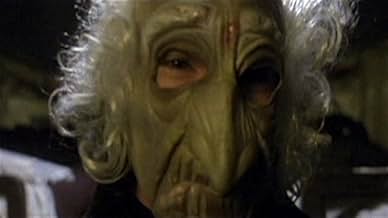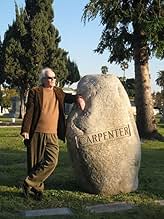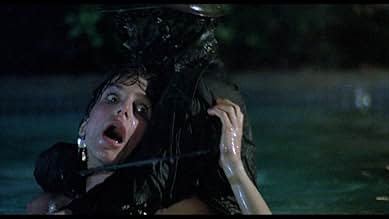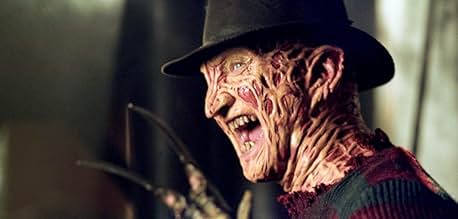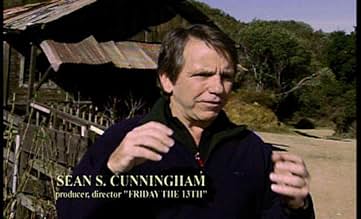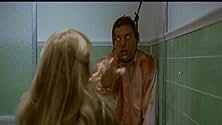VALUTAZIONE IMDb
7,2/10
3715
LA TUA VALUTAZIONE
Aggiungi una trama nella tua linguaA documentary on the history of the slasher film.A documentary on the history of the slasher film.A documentary on the history of the slasher film.
- Regia
- Sceneggiatura
- Star
Amy Holden Jones
- Self
- (as Amy Holden-Jones)
Anthony Timpone
- Self
- (as Tony Timpone)
Recensioni in evidenza
This is an interesting and pretty thorough documentary on the slasher film. It's not as good as reading a book on the subject, of course (there are several now, and this documentary is based on one of the better ones), but you get lots of films clips, and some interviews, not only with the usual horror convention attendees like Tom Savini and Felissa Rose,but also with more obscure characters like the Rabbi Herbert Freed who directed the obscure slasher "Graduation Day" (before he was a rabbi, of course).
What's most interesting for someone like me who is old enough to remember the first wave of slasher movies, is to recall how alarmed adults were at the time by these movies, which look like pretty harmless fun now. I especially remember the way they actually picketed "Silent Night, Deadly Night" because they were upset by the idea of an axe-murdering Santa Claus (in an ideal world these kind of idiots would be met with tear gas and police batons, just like anti-war protesters--who often have a legitimate reason for being upset--often are).
It's also ironic how widely available, thanks to DVD, uncut versions of these movies are today, considering how they were hacked up by American censors back then or outright banned over in Britain. It's probably just as stupid to get worked up about movies like "Hostel" or "Captivity" like people do nowadays. Remember the famous ad-line to "Last House on the Left" (one movie this doc barely mentions, although I guess it isn't really a slasher). "It's only a movie... It's only a movie. . .
What's most interesting for someone like me who is old enough to remember the first wave of slasher movies, is to recall how alarmed adults were at the time by these movies, which look like pretty harmless fun now. I especially remember the way they actually picketed "Silent Night, Deadly Night" because they were upset by the idea of an axe-murdering Santa Claus (in an ideal world these kind of idiots would be met with tear gas and police batons, just like anti-war protesters--who often have a legitimate reason for being upset--often are).
It's also ironic how widely available, thanks to DVD, uncut versions of these movies are today, considering how they were hacked up by American censors back then or outright banned over in Britain. It's probably just as stupid to get worked up about movies like "Hostel" or "Captivity" like people do nowadays. Remember the famous ad-line to "Last House on the Left" (one movie this doc barely mentions, although I guess it isn't really a slasher). "It's only a movie... It's only a movie. . .
This is pretty much what you'd expect from the title: a group of actors, directors and special effects people talk about the slasher genre of the early 1980s. They cover all the big ones, some of the lesser ones, and go over the backgrounds.
How did the Italian films of Mario Bava influence the slashers? Are they anti-woman? Do they make kids do bad things? Is it a dead genre? All of this is covered and more... such as the concept of the "final girl" and other tropes so often found in horror.
I would have liked a bit more history, and maybe more credit given to Bob Clark and "Black Christmas" (which, to me, deserves more recognition than John Carpenter's "Halloween"). But I can't really complain with all these people they found to interview -- getting Carpenter, Craven, Rob Zombie and more to appear on film? Well done.
I have met the man who wrote the book this film is based on, the charming Adam Rockoff. If this film was your idea of education, get his book! Much more than you can cram into a 90-minute film.
How did the Italian films of Mario Bava influence the slashers? Are they anti-woman? Do they make kids do bad things? Is it a dead genre? All of this is covered and more... such as the concept of the "final girl" and other tropes so often found in horror.
I would have liked a bit more history, and maybe more credit given to Bob Clark and "Black Christmas" (which, to me, deserves more recognition than John Carpenter's "Halloween"). But I can't really complain with all these people they found to interview -- getting Carpenter, Craven, Rob Zombie and more to appear on film? Well done.
I have met the man who wrote the book this film is based on, the charming Adam Rockoff. If this film was your idea of education, get his book! Much more than you can cram into a 90-minute film.
This is a pretty good treatment of the thinking that went on behind the scenes of movies like "Prom Night", "Friday the 13th", "Nightmare on Elm Street", "Texas Chainsaw Massacre", and others. The great thing is that the cool stories and insights are told by the key players involved (directors, producers, special effects artists). You get to hear not only their thoughts on the psychology involved, but also about the marketing struggles they had to deal with.
Essentially, this is a documentary which interweaves present-day interviews with film clips from classic 80's horror flicks to give you a behind the scenes look at a genre during its peak period of interest. If you're a horror fan, you'll probably like watching this.
Essentially, this is a documentary which interweaves present-day interviews with film clips from classic 80's horror flicks to give you a behind the scenes look at a genre during its peak period of interest. If you're a horror fan, you'll probably like watching this.
GOING TO PIECES is a fun reflection on the slasher genre, primarily exploring the wave of American slasher flicks that came out since the success of Carpenter's HALLOWEEN in 1978. Other influences such as Argento and Bava are only mentioned in passing, and there are some notable omissions (what about BLACK Christmas?) but for the most part this is a fun and in-depth look at a much-maligned sub-genre of film.
Obviously, the documentary is awash with clips that take up about two-thirds of the running time. Most of these focus on the goriest of the kill scenes in each film, so if that's your bag then you'll enjoy yourself. However, in addition, we get interviews with tons of guys involved with the production of these movies; writers, producers, directors, occasionally stars. You'd expect to see Carpenter and Savini here, but I appreciated the less well-known faces too. GOING TO PIECES is a great watch for anyone with even a minor interest in the slasher genre.
Obviously, the documentary is awash with clips that take up about two-thirds of the running time. Most of these focus on the goriest of the kill scenes in each film, so if that's your bag then you'll enjoy yourself. However, in addition, we get interviews with tons of guys involved with the production of these movies; writers, producers, directors, occasionally stars. You'd expect to see Carpenter and Savini here, but I appreciated the less well-known faces too. GOING TO PIECES is a great watch for anyone with even a minor interest in the slasher genre.
I was raised on Dracula and Frankenstein, and was living in Europe during the rise and fall of the slasher film. I have not seen most of the films mentioned in this film.
However, I was pleased at the presentation and now have a sense of history as to how the slashers came into being, the influences of Italian directors like Bava and Argento, the importance of the makeup and special effects guys, and the guttural significance of slasher films.
It was extremely interesting to see the directors and producers and actors and how they felt about the work they had done and were doing. I was also excited to see people like George Clooney, Jamie Lee Curtis, Cary Elwes, Robert Englund, Sid Haig, Heather Langenkamp, Dina Meyer, Bill Moseley, and many more in clips from their performances.
Of course, I am always happy to see Christa Campbell.
However, I was pleased at the presentation and now have a sense of history as to how the slashers came into being, the influences of Italian directors like Bava and Argento, the importance of the makeup and special effects guys, and the guttural significance of slasher films.
It was extremely interesting to see the directors and producers and actors and how they felt about the work they had done and were doing. I was also excited to see people like George Clooney, Jamie Lee Curtis, Cary Elwes, Robert Englund, Sid Haig, Heather Langenkamp, Dina Meyer, Bill Moseley, and many more in clips from their performances.
Of course, I am always happy to see Christa Campbell.
Lo sapevi?
- QuizExecutive Producer Michael Ruggerio had previously worked on The American Nightmare (2000), one of the documentaries that inspired Going To Pieces. He always said he wanted to do a sequel about the Slasher movies of the 1980's. He happened to be good friends with author Adam Rockoff. After producer Rudy Scalese optioned the book rights to Going to Pieces and befriended Adam Rockoff, Adam made an introduction to Ruggerio who was now an executive at STARZ and championed the documentary to be made.
- Citazioni
John Carpenter: New talents come along, old talents fade away.
- ConnessioniFeatures La guerra dei mondi (1953)
I più visti
Accedi per valutare e creare un elenco di titoli salvati per ottenere consigli personalizzati
Dettagli
- Data di uscita
- Paese di origine
- Lingua
- Celebre anche come
- Going to Pieces - el éxito y la caída del cine de destazamiento
- Luoghi delle riprese
- Los Angeles, California, Stati Uniti(Hollywood Forever Cemetary)
- Aziende produttrici
- Vedi altri crediti dell’azienda su IMDbPro
Botteghino
- Budget
- 600.000 USD (previsto)
Contribuisci a questa pagina
Suggerisci una modifica o aggiungi i contenuti mancanti



